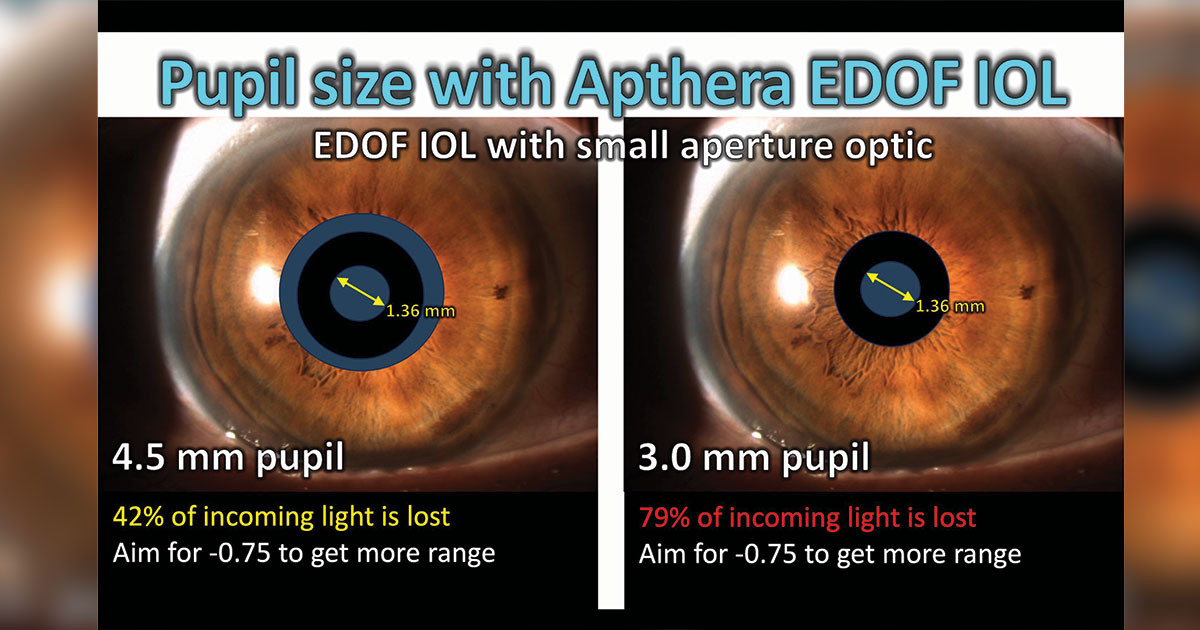Pupil size plays important role in extended depth of focus IOLs
For all people, pupil size has an important role in balancing incoming light with depth of field to optimize vision depending on the ambient light. The pupil even constricts when we accommodate to maximize vision for near work.
Young healthy patients have the best possible combination of a dynamic pupil with a large degree of accommodation, but this declines with age. We know that lens elasticity declines with age, and that causes a decrease in the accommodative amplitude, resulting in presbyopia. Pupil size also changes with time, and as we age, it tends to decline. Perhaps these smaller pupils are a way for our eyes to help offset the declining accommodation, thereby maintaining a more functional visual range.


When we use any IOL during cataract surgery, the pupil size is important for determining the depth of field that we achieve. With some newer extended depth of focus (EDOF) IOL designs, this becomes even more critical because it can affect the way we perform IOL calculations and functional vision in dark environments.
The Alcon Vivity EDOF IOL uses a central 2.2 mm diameter beam-shaping element to elongate the depth of focus (Figure 1). In patients with a larger 4.5-mm pupil, about 22% of the incoming light will enter through this central 2.2-mm zone while the remaining goes through the rest of the optic. In this case, the visual range may be less due to the larger pupil, but we should still be able to achieve our target of emmetropia. We would aim for plano to get plano. However, if a patient has a 2.5-mm pupil, 80% of the incoming light would be going through the central 2.2 mm wide zone of the optic, which has a stronger effective dioptric power. These patients can end up with a myopic result if we aim for emmetropia. In this case, aiming for +0.5 D would be better to achieve our target of plano.

For EDOF IOL designs such as the Johnson & Johnson Vision Symfony, the diffractive rings are throughout the optic, and thus it is less dependent on pupil size for performance (Figure 2). A patient with a small pupil may achieve a bit more range due to the pupil size, but the lens generally performs well with all pupil sizes. Importantly, this lens is less prone to myopic surprises, and we can aim for plano to achieve emmetropia independent of pupil size.
We know that a smaller camera aperture allows for a wider depth of field, and the same applies to pupils in the eye. We can extend this benefit more by using a small aperture EDOF IOL such as the Bausch + Lomb Apthera (Figure 3). This IOL has a central 1.36-mm opening that becomes the new de facto light entrance until the pupil expands past the 3.23-mm outer edge of the blocking ring. For a patient with larger 4.5 mm diameter pupils, there is light entering through the central aperture and also around the edge of the blocking ring. This means that about 42% of incoming light is lost, which is tolerable in most ambient lighting situations. However, when the pupil goes down to 3 mm in diameter, the only light entering the eye is via the central aperture, which means that 79% of the incoming light is lost when compared with a standard IOL optic.
Because the pinhole effect of the small aperture helps to address residual refractive errors, this IOL can also address mild degrees of corneal astigmatism and residual myopia. For this reason, we can aim for a postop goal of –0.75 D regardless of pupil size to still achieve good distance vision while extending the intermediate and near vision range.

As surgeons, we want the most surgical options in our toolboxes so that we can tailor the surgery to our patients. All these EDOF IOLs have a role in our clinical practices, but we must take into account patient anatomy, particularly pupil size, to achieve the best visual results.
A video of these surgeries can be found at https://cataractcoach.com/ ?s=EDOF.
- For more information:
- Uday Devgan, MD, in private practice at Devgan Eye Surgery and a partner at Specialty Surgical Center in Beverly Hills, California, can be reached at devgan@gmail.com; website: www.CataractCoach.com.
